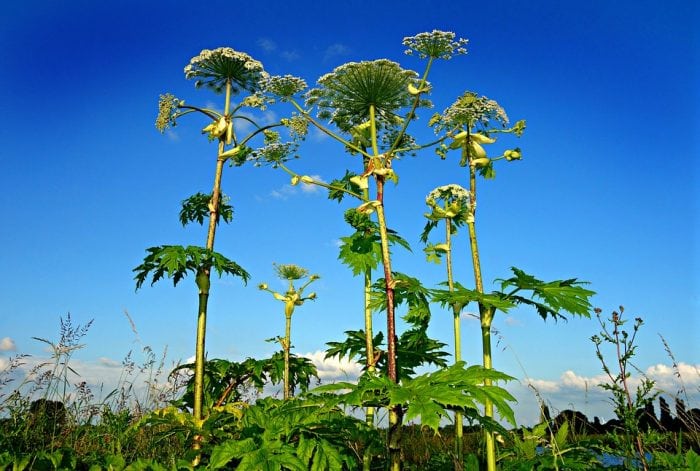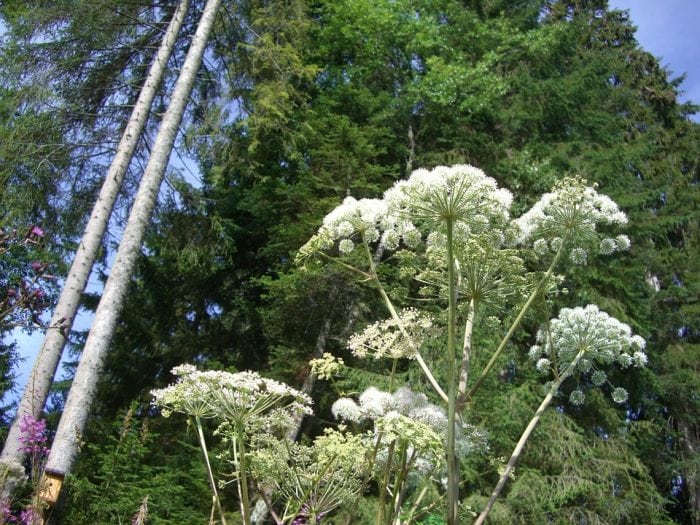
A plant known as giant hogweed, sometimes just hogweed, may be spreading into the state of Virginia. Local plant experts and authorities are concerned about the appearance of the plant within the state because hogweed creates a clear sap that is quite dangerous. Exposure to the plant’s sap can cause intense blisters, third-degree burns, and potentially permanent blindness.
While hogweed has can currently be found across the northern parts of Canada, parts of the Pacific Northwest, and northeastern US states (like Maine, Massachusetts, and New York) it has been sighted in Virginia for the first time and officials are paying attention to the possible spread of the plant.
What Is Giant Hogweed?
Hogweed can grow quite tall with long, jagged leaves and thorns. The plant has a canopy of white blooming flowers. The plant looks rather innocuous but the danger it poses means that officials recommend calling professionals to remove the plant if you find it growing in your garden. Recently around 30 hogweed were found growing in Clarke County, Virginia and residents of the area have been asked to report any new sightings. Hogweed reproduces by releasing around 50,000 seeds during the late summer which are carried by water or wind to fertile soils.
The particular plant known as giant hogweed is the species Heracleum mantegazzianum, and it belongs to a genus of around 60 different species of herbs in the Apiaceae family. There are other species of Heracleum, or hogweed, including Heracleum persicum (Persian hogweed), Heracleum maximum (cow parsnip) and Heracleum sosnowskyi (Sosnowsky’s hogweed).
Dangers Of Hogweed
If one is exposed to the sap of hogweed they can quickly develop painful blisters and third-degree burns can even occur due to exposure to the sap. This occurs because the plant’s sap contains a group of chemicals known as photosensitizing furanocoumarins, which essentially inhibits your skin’s ability to protect itself from the UV rays in sunlight. The chemicals enter the epithelial cells of the skin and bind to the DNA in them, leading to cell death. Without this protection within 15 minutes of exposure blisters can appear that grow in severity for the two hours following exposure. Some people require the use of sunscreen for months afterwards to prevent blisters and burns until their skin can recover.

Photo: MabelAmber via Pixabay, CC0
Hogweed isn’t the only plant to contain furanocoumarins, other common plants like celery, parsnips, and carrots contain them too. One normally wouldn’t handle them enough to cause any problems, though there are reports of farmers and gardeners handpicking large amounts of the plant and sometimes breaking out in painful rashes and blisters. Like hogweed, these plants are members of the Umbelliferae plant family.
The condition exposure to furanocoumarins causes a condition known as phytophotodermatitis or “Margarita photodermatitis”, colloquially referred to as “lime disease” (not to be confused with “lyme disease”). The fact that too much handling of citrus fruits can cause the condition is responsible for the moniker. In addition to the blisters caused by the condition, hyperpigmentation of the skin is another symptom of the condition. Even after one has recovered from phytophotodermatitis purplish scars are left behind that can last for years.
The sap, which the plant has evolved as a defense mechanism, is particularly dangerous if it gets into people’s eyes. Media reports suggest the sap can easily damage the eyes leading to permanent blindness, although research is less clear on this particular danger. The dangerous nature of the sap has lead authorities in many states to call the invasive plant a “pest plant” or classify it as a “Class A noxious weed”. It remains illegal to transport the seeds of the plant or plant it in many places.
The Spread Of Hogweed
Hogweed was originally native to regions around the Black Sea before it spread out to parts of Europe and North America. The dangerous nature of the plant wasn’t enough to deter gardeners from importing it to the North American continent in the 19th and early 20th century. The plant was valued for its unique looks and use as an ornamental plant in gardens, which encouraged collectors to import the plant.
The practice of using the plant as to spruce up the look of one’s garden is likely how it found its way into Virginia. The plant was reported in the garden of a home where hobby gardeners lived, and experts suspect it has been growing for the past 40 years, likely planted there by the original owners of the home. The home’s current owners were responsible for suspecting the plant was hogweed and alerting experts. Virginia currently classifies hogweed as a noxious weed meaning the plant can’t be sold or bought within the state. The federal government’s laws regarding hogweed ban the import of the plant into the US and also ban moving the plant across interstate without a permit.
Hogweed In Virginia?
State authorities say that the hogweed found at the home was removed and that other sightings of hogweed around Virginia have been reported but are as of yet unconfirmed. While officials say it’s currently unlikely that giant swarms of hogweed will spread across Virginia, it is important that any sightings of the plant are reported immediately. Hogweed is difficult to contain once it starts to spread.

Photo: Erge via Pixabay, CC0
“We’re fairly confident it hasn’t spread. If it had been found in the wild, alarm bells would be going off,” says Kevin Heffernan, a biologist with Virginia’s Department of Conservation and Research.
Most animals don’t feed on the plant meaning that there are few natural control methods that can stop hogweed’s proliferation through a region once it gets started. The plant doesn’t just pose a danger to humans, it may also pose a danger to other vegetation and by proxy a danger to other animals.
The Centre for Agriculture and Bioscience International (CABI), based in the UK, explains that the plant leads to large changes in the vegetation makeup of a landscape. CABI states:
It is an undesirable invader on account of its large size, prolific seed production and vigorous growth leading to gross changes in vegetation, obstruction of access to river banks [and] soil erosion.
If you are exposed to the sap of hogweed it is recommended that the affected area is washed thoroughly with soap and water. The area should then be protected from exposure to sunlight with sunscreen or long clothing. Painkillers and bandages may be able to help relieve some of the pain, though steroid creams are sometimes needed. Seek medical attention if the sap gets in your eyes.









